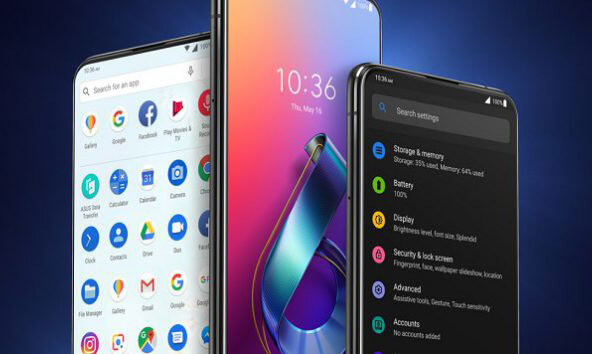We know Android as the world’s most prominent mobile device operating system. Android continues to grow rapidly and now controls 76% of the mobile operating system market share. Since its acquisition, Google has made Android an open source operating system. This means that the source code of the Android operating system is available and can be used by anyone.
Developers can download and modify the source code to create their own version of Android if they know how to do it. Developers continue to use the Android base code but can add a look and feel known as a user interface (UI) skin or Android skin as a characteristic and also to provide a different and better user experience. .
You can tell the difference in “look and feel” when using two or more brands of Android smartphones such as Samsung, Xiaomi and Realme. Each has its own custom user interface skin. This is one of the strategies of smartphone manufacturers to dominate the market. Android smartphones are successful in the market not only lies in the best hardware specifications, but also good software.
The following are the six best user interface (UI) skins or Android skins on Android smartphones:
1. OxygenOS (OnePlus).
OxygenOS, developed by Chinese smartphone manufacturer OnePlus, is considered the best user interface (UI) skin or Android skin. Although OxygenOS is considered to be similar to stock Android i.e. the most basic version of Android, it still has major improvements or optimizations that make it superior. What’s great about OxygenOS is that it has no bloatware.
OxygenOS has a clean and neat user interface skin. The icons look like a refined version of stock Android. Animation can run smoothly and quickly at the same time according to the tagline “fast and smooth” that is carried. OxygenOS offers many features such as an app locker that allows the use of additional passwords to open certain apps and parallel apps which is useful if you have multiple social media accounts.
2. MIUI (Xiaomi).
At first, Xiaomi was a small software company. In April 2010, Xiaomi released a custom ROM called MIUI. This is the company’s first step to enter the hardware market. Now, Xiaomi is known as one of the highly reckoned smartphone manufacturers. A row of Xiaomi smartphones with the MIUI skin user interface are in demand in the market.
Unlike OxygenOS, MIUI has a lot of bloatware and ads spread across the user interface skin. However, you don’t need to worry because all of these can be removed easily. MIUI has colorful icons, iOS-inspired brightness slider and a dark mode feature that has proven to be useful and effective. MIUI also supports multitasking with floating windows.
3. One UI (Samsung).
Before One UI (often written as OneUI), Samsung had used the Samsung Experience UI or TouchWiz user interface skin. However, the Samsung Experience UI or TouchWiz itself has received a lot of criticism because it is full of bloatware, slow and heavy animations and other problems related to stability. One UI itself is the third version of TouchWiz which has received a massive upgrade.
One UI was first present on the Samsung Galaxy S10. One UI is intended to help users focus more on tasks by making user experience skins cleaner. The icons in One UI are redesigned and look great with rounded corners. The Night mode feature is still the best implementation of this UI skin made by Samsung. One UI also gets improvements in stability, animation speed and smooth user experience.
4. Realme UI (Realme).
After a long time using Oppo’s ColorOS, Realme smartphones can now use their own user interface skin, Realme UI. Realme UI itself is a development of ColorOS 7 and Android 10. Realme UI brings many new features, providing improved performance and visual enhancements on Realme smartphones. Realme UI has a light design that is clean and smooth and pleasing to the eye.
Realme UI focuses on four things, namely the color system, icons, wallpapers and animations. The icons on realme UI can be customized with your choice of style, shape and size. Realme UI is equipped with several cool features such as Focus mode, Dual-Mode Music Share, Three-Finger Screenshot Gesture and Personal Information Protection. Present for the first time on Realme C3, Realme UI is also present on several previous Realme smartphones.
5. ZenUI (Asus).
ZenUI is a user interface skin or Android skin developed by the Taiwanese company ASUS for the ASUS Zen series smartphone products. ZenUI’s user experience is based on the premise that technology is built to meet your needs. ZenUI is built to be efficient with modern icons, beautiful color and animation themes and a clean layout.
Some good features can be found in ZenUI such as Share Link for easy content sharing, Party Link for sharing content in real-time at certain moments, Remote Link as WIFI or Bluetooth remote control for PC or laptop, What’s Next which reminds you of tasks and next important event and Do It Later which reminds various tasks to do later.
6. Stock Android UI.
Stock Android also known as vanilla or pure Android is the most basic version of Android or an unmodified version of Android. Stock Android has no bloatware meaning there are no pre-installed apps by the smartphone manufacturer that you might not need. Stock Android gets the quick and first update that is upgraded to the latest Android version.
Stock Android has a clean and minimalistic design that people generally like. The simplicity of stock Android makes it a great choice for beginners because it can be so much easier. Because there are no changes or adjustments by smartphone manufacturers as in user experience (UI) skins in general, stock Android is considered to be able to provide a much better Android experience.

